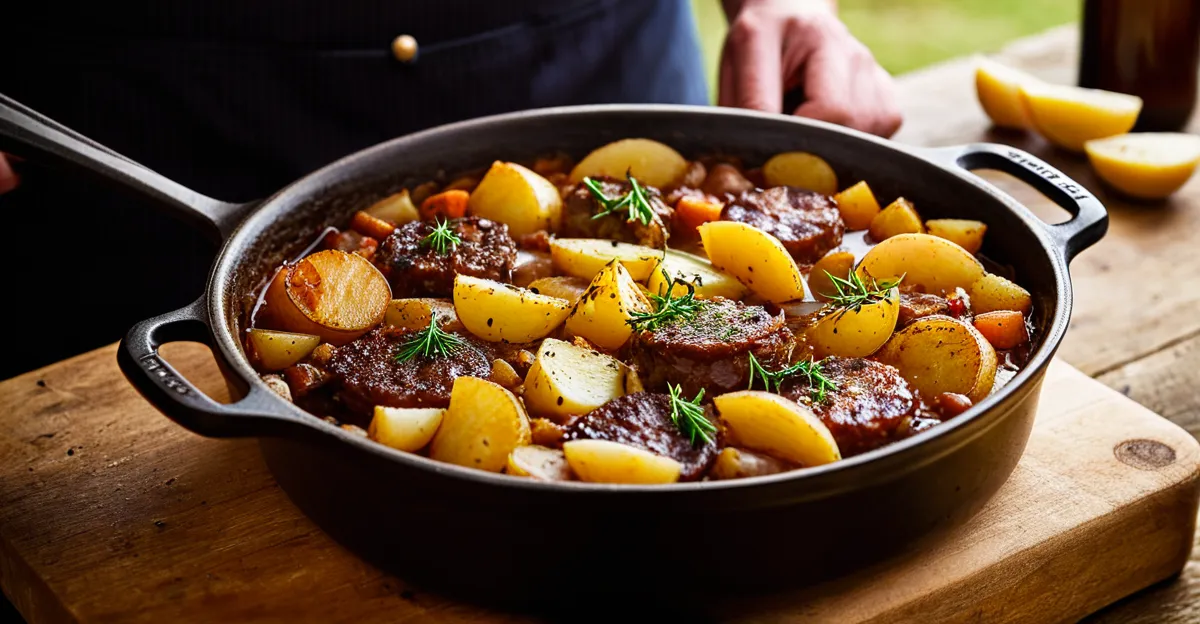Understanding the Ideal Texture of Lancashire Hotpot
Achieving the perfect Lancashire hotpot texture involves balancing tender meat, creamy-then-crisp potatoes, and a rich, thick gravy. The texture is a defining characteristic that distinguishes this traditional dish from others. The meat should be slow-cooked until it becomes soft and succulent, almost melting in the mouth. The potatoes, which top the hotpot, require a careful blend of creaminess beneath a crisp, golden layer. This contrast is essential to the dish’s appeal.
Traditional Lancashire hotpot characteristics emphasize a harmonious mouthfeel where every bite contains the interplay of luscious gravy, soft lamb, and the satisfying bite of the potato crust. Unlike stews that remain uniformly soft, the hotpot’s texture layers are deliberate: meat and vegetables under a layer of thinly sliced potatoes that develop a slight crunch with slow oven cooking. This texture combination sets Lancashire hotpot apart, making it both hearty and intriguing.
Topic to read : How can you recreate a traditional English afternoon tea at home?
In summary, texture definition for Lancashire hotpot is more than softness; it’s the interaction between tender, creamy, and crisp layers that create an authentic culinary experience.
Ingredient Preparation for Optimal Texture
Proper ingredient preparation is critical to achieving the perfect texture in a Lancashire hotpot. Selecting the right Lancashire hotpot ingredients starts with choosing tender cuts of lamb or beef. Ideally, cuts like neck or shoulder are preferred due to their balance of connective tissue and fat, which break down during slow cooking to create a melt-in-the-mouth texture without turning dry.
Also to read : What are the secrets to making authentic British scones?
Potatoes must also be prepared thoughtfully. The ideal potato is one that holds its shape but softens pleasantly under heat, such as Maris Piper or King Edward. Uniform potato slicing—usually about 3–5 mm thick—ensures consistent cooking and helps develop the signature creamy-then-crisp top layer. Irregular cuts can lead to uneven textures, with some parts undercooked and others overdone.
Additional vegetables like onions contribute to the overall mouthfeel. Slicing onions evenly allows them to soften uniformly, infusing the dish with sweetness and moisture that complement the meat’s tenderness and potato’s texture. Consistency here guarantees that every layer contributes to the robust, balanced feel prized in traditional Lancashire hotpot characteristics.
Layering and Assembly Techniques
Achieving the perfect Lancashire hotpot texture begins with meticulous layering Lancashire hotpot ingredients. Proper layering ensures each element retains its ideal texture. The base typically starts with tender meat nestled beneath evenly sliced vegetables. This foundation helps the slow-cooked meat remain succulent while the vegetables soften gradually without turning to mush.
The hotpot assembly proceeds by topping these layers with thin, uniform potato slices. This arrangement is crucial as the potatoes develop the signature creamy-then-crisp texture central to traditional Lancashire hotpot characteristics. Overlapping slices slightly during assembly encourages a cohesive crust that crisps beautifully when baked.
Incorporating stock or rich gravy between these layers enhances moisture retention and flavor melding, aiding texture control during assembly. The liquid prevents dryness in the meat and vegetables while supporting the potatoes’ tender underlayer.
Mastering texture control during assembly involves balancing these components—ensuring that the meat stays juice-filled, vegetables maintain slight firmness, and potatoes achieve the iconic golden crisp topping. This precise layering technique distinctly sets Lancashire hotpot apart, delivering a delightful mouthfeel unique to this classic British dish.
Cooking Methods and Temperature Control
Achieving the perfect Lancashire hotpot texture hinges on precise oven temperature and cooking duration. Slow-cooking at a moderate temperature, typically around 150-160°C (300-320°F), gently breaks down connective tissue in the meat, ensuring it becomes tender without drying out. This low-and-slow approach allows the potatoes to soften beneath while gradually developing a golden, crisp crust on top.
Lancashire hotpot timing is critical; cooking generally spans 2 to 3 hours. This duration guarantees the rich, thick gravy has time to thicken and infuse flavors fully, while the meat reaches that desired melt-in-the-mouth softness. Interrupting this slow cook risks uneven textures, either tough meat or underdone potatoes.
Using a lid or foil during the initial phase retains moisture and prevents the hotpot from drying out. Removing the cover toward the end encourages the top potato layer to crisp beautifully. This balance of covered and uncovered cooking optimizes texture control during assembly by managing moisture levels precisely.
Mastering these timing and temperature guidelines ensures each layer—soft meat, creamy potatoes, and crisp topping—forms the signature contrast that defines traditional Lancashire hotpot characteristics.
Visual Cues and Texture Troubleshooting
Knowing how to check Lancashire hotpot texture is vital for achieving perfection. A key visual indicator is a golden potato top that looks crisp but not burnt. When you see bubbling gravy around the edges, it signals that the interior is hot and thickening as expected. The classic fork-test helps confirm tenderness: the meat should easily break apart, while potatoes beneath remain creamy without sinking into mush.
If you encounter texture issues, such as dryness, compensate by adding a splash of stock or covering the dish to retain moisture. Mushy potatoes often result from overcooking or excessively thin slices; adjusting potato thickness at the start or reducing cooking time can prevent this. Under-cooked potatoes suggest the need for longer cooking at a steady temperature or pre-boiling slices briefly before assembly.
For last-minute texture troubleshooting, removing the lid in the final cooking phase encourages crisping of the potato topping without compromising moisture inside. Conversely, if the topping browns too quickly, loosely cover with foil. These small adjustments ensure your Lancashire hotpot delivers traditional, perfect Lancashire hotpot texture with balanced tenderness and crispness, central to authentic traditional Lancashire hotpot characteristics.

